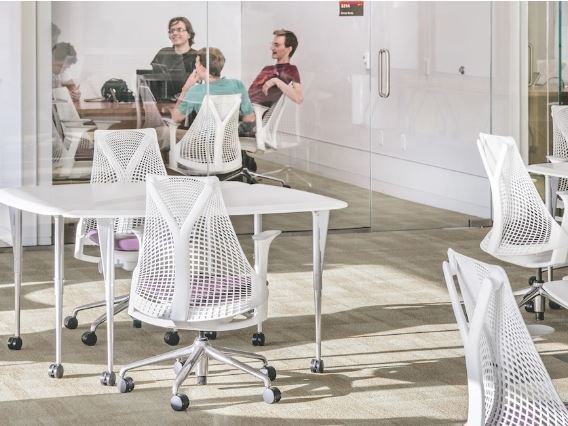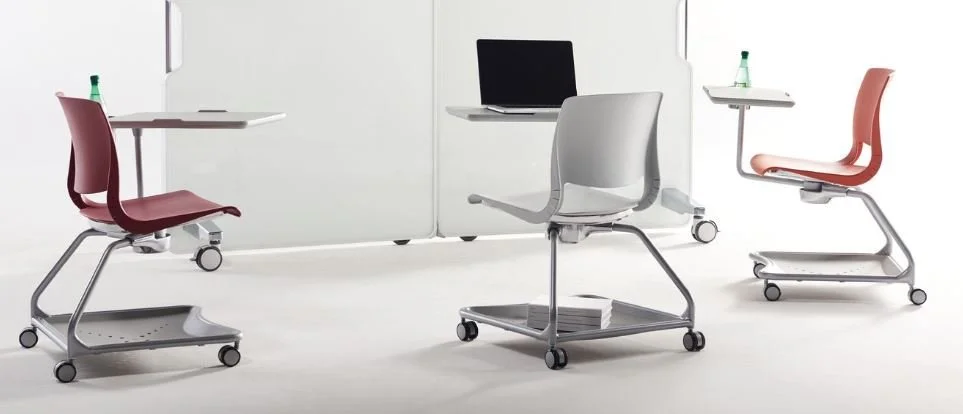Designing An Active Learning Classroom
Active learning classrooms encourage the flow of people, conversations, ideas, and information. Unlike the typical college lecture hall, active learning classrooms do not have an obvious “stage” or front of room. Students are not expected to sit still, face forward, be quiet, and listen to the instructor. Instead, students are encouraged to collaborate, create, and transform the classroom space to support their learning. Yes, you can move the furniture! Yes, you can decide where you want to sit! Yes, you can draw on the blackboard!
Designing for active learning involves the following strategies:
Natural Lighting or Intelligent Lighting- For optimum focus and security, good lighting is at the top of the list. A combination of natural light and intelligent lighting designed to be soft, even, and comfortable infuses an environment with energy and invites students to safely experience the full parameters of the space.
A Variety of Movable Furnishings & Tools- The furniture options should support group work, individual study, and socializing though the use of lounge seating, swivel chairs, stand-up tables, moveable tables, stacking chairs, whiteboards, plug-and-play technology, and privacy screens.
Warm Colors & Natural Textures- Warm colors such as red, orange, and yellow have been recognized as the preferred colors to maintain learners' attention and stimulate their active participation. Combining these with neutral colors and natural textures creates a balanced setting for comfortable, long-term learning.
Acoustics- When a flex space is hosting multiple activities, acoustic treatments play a major role in reducing distractions and enhancing focus. By dividing the area into acoustic zones ranging from loud to quiet and adding the appropriate levels of sound absorption materials and white noise technology to each zone, a comfortable learning environment can be achieved.
Environmental Graphics- Incorporating Environmental Graphics is one of the creative approaches interior designers use to enhance a space with positive messaging that reinforces uplifting thoughts and fosters creative thinking. This involves using graphic artwork and signage to create a sense of place and community pride while also aiding in intuitive wayfinding.
Sharon Beaudry, J.D., Oregon Institute of Technology, Professor of Management and Active Learning Researcher, sums up the positive results. “There’s a growing body of research about the importance of student success, wellness and engagement. These active learning classrooms do a remarkable job of motivating learners. Because they don’t mimic typical classrooms, they make it easier for students and faculty to immediately engage with each other and with learning.” Beaudry’s students found the ALC does a much better job of helping them communicate their ideas and take risks that support innovation. They also report the ALC environment gave them confidence to participate, feel important in class, and help them make friends — all important aspects of student retention.
Sayl Task Chair by Herman Miller
Libraries enrich the soul and the intellect. But they also need to enrich the body, providing comfort and healthful spaces that keep students refreshed, even as they spend long hours studying.
Variable HybrED Chair by Teknion
A mobile, compact, self-contained individual desk and chair that can easily flex between focused, interactive, and open space group activities
Regard Lounge Seating by Steelcase
Providing comfort and durability for the many postures of socializing and study, this system is designed for reconfigurability and replacement, making it adaptable to evolving needs.
Paradolia by Kimball International
This collection of floor screens, mobile markerboards and wall-mounted tack boards, provides valuable communication tools and space dividers in soft shapes and sound absorbing materials.





